A Brief History of One Piece Video Games, Part 1
by Todd Ciolek,One Piece had a short voyage to success. Creator Eiichiro Oda devised the pirate epic as a series of one-shot stories in 1996, and One Piece was a prominent Shonen Jump manga by 1997, an anime OVA by 1998, and a TV series by 1999. And from there it took the next logical step for any major name in successful action manga and anime: video games.
Of course, no company would throw an untested new anime hit into big-budget video games. For a canny toy purveyor like Bandai, it's common practice to start off fresh shonen-manga successes with games on handheld systems. They're easier to design, they're cheaper to produce, and in the 1990s kids were much more likely to own a Game Boy than a Sega Saturn or a PC-FX or a $700 Panasonic 3DO. However, the Game Boy wasn't Bandai's first choice for a One Piece title back in 2000, not when they had their own portable game system in the WonderSwan.
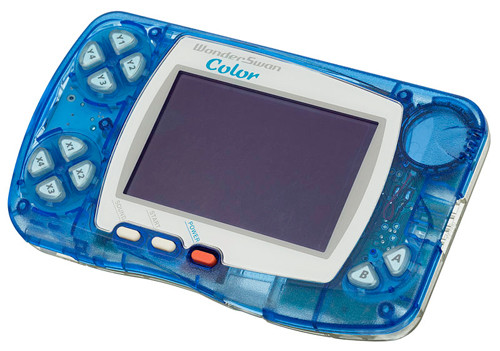
The WonderSwan will go down in handheld history as an obscurity. It was the creation of Gunpei Yokoi, designer of the Game Boy and many other Nintendo innovations, but the little device never mustered a library to challenge Nintendo's Game Boy Color in sheer market dominance (or SNK's Neo Geo Pocket Color in overall quality). Even so, Bandai believed in the WonderSwan enough to cram it with anime licenses, and so in July of 2000 the first One Piece game debuted there. Like many Bandai adaptations, it was prefaced with “From TV Animation” in its title, presumably so customers wouldn't confuse it with any games based on the One Piece line of Norwegian jumpsuits.
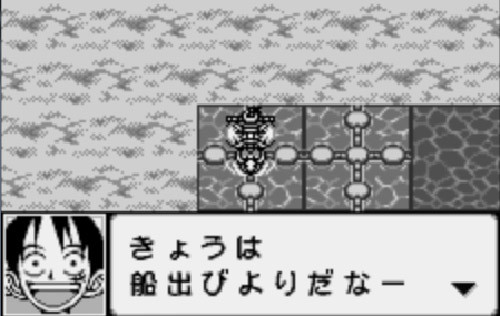
One Piece: Become King of the Pirates! (Mezase Kaizoku-O!) takes no risks in adapting a rollicking Shonen Jump manga to a black-and-white handheld. Monkey D. Luffy and the rest of the Going Merry crew steer their vessel through an aquatic board game, using cards to plot a course and wage ship-to-ship combat. It's all meant for manga fans who might not be adept at action games, and it serves to showcase the WonderSwan's neatest idea: you'll explore the seas while holding the system horizontally, but rotate it vertically for the actual battles. Such was the WonderSwan's legacy.
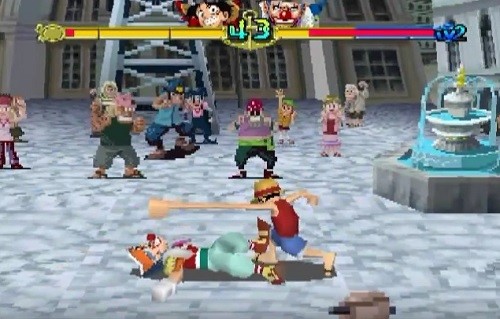
One Piece didn't wait long to graduate from portable systems. One Piece Grand Battle! brought One Piece to the PlayStation and wisely turned the series into a fighting game, one where large-headed versions of the characters belt each other around 3-D stages. If the languid jumps and loose-knit combos did not match the standards for a high-end fighter, it at least delivered over fifteen playable characters from the East Blue and Whiskey Peak story arcs; a paltry selection by today's standards, but substantial in its day.
Grand Battle! would prove the most resilient sub-series in the One Piece line, as it spawned two numbered sequels and a multitude of less directly linked follow-ups. For fans of One Piece in the West, Grand Battle games were reasonably popular imports in the years before One Piece titles saw localization. European fans had it easier: the first Grand Battle came there in 2003.
The original Grand Battle! was also the debut of a little development house called Ganbarion. They're an intriguing outfit in some ways, as they made an innovative, bleak, and still underrated Wii action game called Pandora's Tower. Yet Ganbarion works waist-deep in anime licenses to pay the bills, and you'll see them time and time again throughout the One Piece game library.
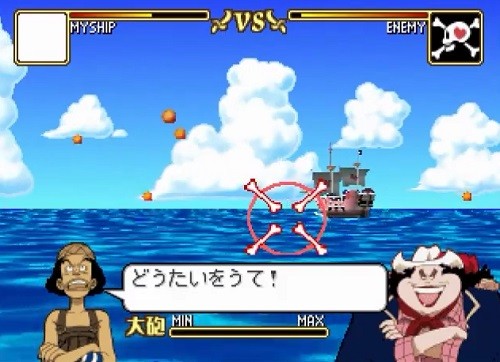
The second One Piece outing for the PlayStation, subtitled Set Sail, Pirate Crew! (Tokidase Kaizokudan!) doesn't lack in ambition. It's an RPG starring the Going Merry crew in their early adventures, and both the side-view battles between pirates and the naval clashes among ships are visually impressive for a PlayStation outing. The sheer volume of text ruled out any release beyond Japan in 2001, of course, as One Piece hadn't yet gained an international gaming foothold.
By 2001, Bandai realized that the WonderSwan would never topple the Game Boy family. One Piece: The Dawn of Luffy's Dream Pirate Crew! (Yume no Kaizokudan Tanjou!) hit the Game Boy Color that year and stuck to an RPG of simple design. Luffy, looking like a sprite edit of the original Pokemon protagonist, wanders towns from an overhead perspective and fights foes in a rudimentary battle grid. Today, the game seems as though it was hacked together from an unrelated RPG by some enterprising fan with a name like NamisHusbando420.
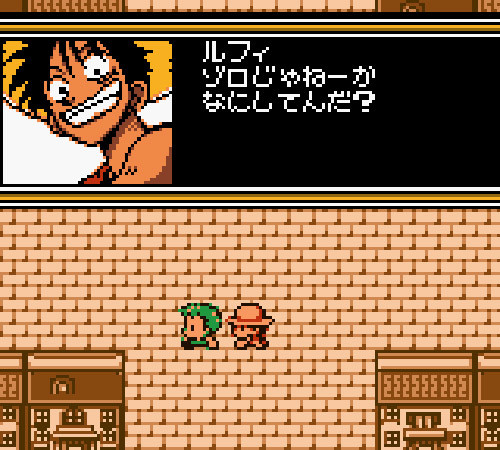
Bandai and developer Alpha Unit (who cranked out such forgettable RPGs as Eternal Eyes and Khamrai) could've done better, but the Game Boy Color seldom discouraged mercenary cash-ins. One Piece: Grand Line Dream Adventure Log (above) was a slightly more impressive RPG when it arrived in 2002, and yet one could sense Bandai's priorities still lay with their own goofily named handheld.
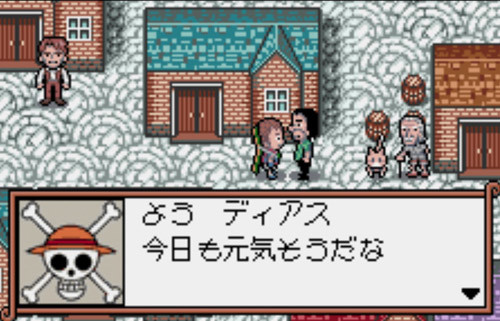
Indeed, Bandai would not forsake the WonderSwan so easily. The WonderSwan Color had replaced its black-and-white ancestor late in 2000, and it needed One Piece. Legend of Rainbow Island (Niji no Shima Densetsu) trots out an original story for the Going Merry crew, here joined by a new, boomerang-wielding crewmember named Dias. The WonderSwan Color pushes better graphics than its Game Boy competitor, with large character sprites and battles that let the pirate heroes knock enemies around the playfield. Don't get too attached to Dias or his friend Atoli, though. They're never seen again in One Piece canon.
Indeed, the WonderSwan Color enjoyed five One Piece games. Shortly into 2002, the system received One Piece: Treasure Wars, a board game distinguished mostly by sprites and backgrounds with much more detail than the similarly big-headed ones in Game Boy Color games. Treasure Wars 2: Return to Buggyland had much the same premise with much the same look and even showed up in the same year. Bandai was clearly not worried about overstacking the WonderSwan library.
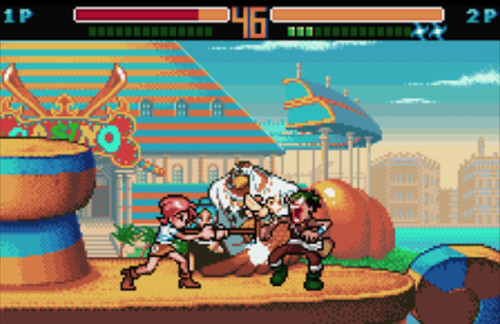
More impressive was One Piece Grand Battle Swan Colosseum. A 2-D fighter in the tradition of the console Grand Battle games, it has surprisingly detailed animation for its format, managing a rubber-limbed Luffy sprite on the WonderSwan's tiny screen. It's also the most approachable One Piece title for Wonderswan owners who don't know a lick of Japanese.
Who was the early breakout star of One Piece? Probably Monkey D. Luffy himself, but you could make a case for Tony Tony Chopper, the crew's little shapeshifting deer doctor. As evidence, you might submit One Piece: Chopper's Big Adventure (Chopper no Daibouken), the last of the One Piece titles on the WonderSwan.
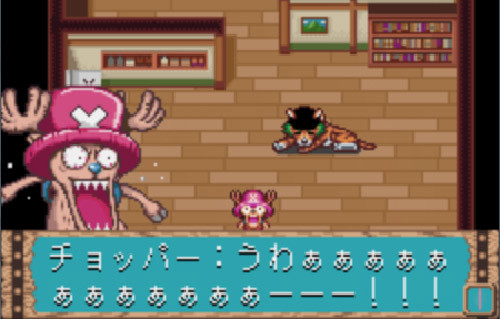
The action-RPG finds the Straw Hat Pirates on an island that mysteriously turns them into animal-people and posts them to DeviantArt. It's up to Chopper, the only one of the crew uncursed (or perhaps the only one pre-cursed), to get his comrades back to normal. The overhead gameplay resembles a dungeon-crawler of basic design, but it's nice to see Chopper get the spotlight.
Chopper's Big Adventure would be among the last crop of WonderSwan Color games, however, as Bandai's handheld went the way of the Playdia after 2003. Not that this had kept One Piece games from other systems. The PlayStation saw Grand Battle 2 in 2002, expanding the first game's roster and covering much of the Alabasta arc.
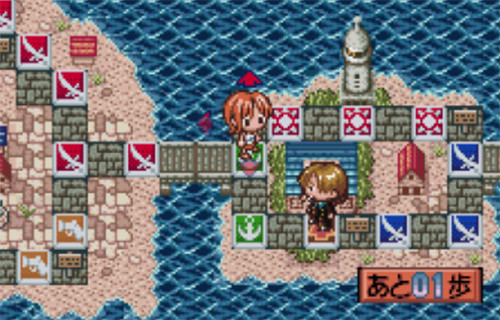
One Piece didn't jump directly to the system-wars frontrunner PlayStation 2, but rather to the GameCube. 2002's One Piece: Treasure Battle is an arena brawler where the focus is as much on capturing flags (or treasure chests) as it in on belting around rival pirates and fellow crewmembers. Its multiplayer approach benefits most from the GameCube's four native controllers, which was a selling point for systems before everything went wireless in the next generation.
Elsewhere, Bandai stopped trying to avenge the WonderSwan and greenlit One Piece games for its assassin, Nintendo's Game Boy Advance. One Piece: The Big Secret of the Seven Phantom Islands (Nanatsu Jima no Dai-hiho) appeared in 2002, delivering a routine but colorful RPG with the sort of nice 2-D animation GBA games frequently did well. For those who found this too complex, Aim! The King of Belly played it simpler in 2003 with a board-game simulation of pirate battles.
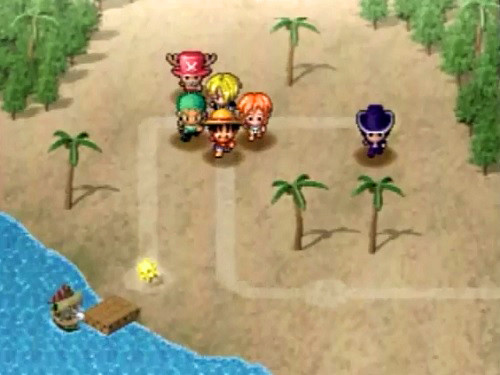
If you watched the One Piece anime through its dullest moments, you might remember the Ocean's Dream Arc, one of those seemingly original storylines that fans reflexively, though often accurately, brand as “filler.” Well, it wasn't created by the anime just to kill off broadcast space—it's based on One Piece: Ocean's Dream!, a 2003 PlayStation game. It's a board game in terms of play mechanics, and the storyline finds a mysterious stranger robbing the crew of their memories. It also ended the line of One Piece games on the PlayStation, which was losing even the reliable anime titles to newer consoles.
By the end of 2003, Bandai had moved to these greener pastures. Grand Battle! 3, another Ganbarion-made brawler, arrived on the GameCube and the PlayStation 2, sporting a bigger roster than its predecessors and, naturally, better graphics. Grand Battle 3's other notable contribution? It marked the point where Bandai stopped putting “From TV Animation” in the titles of every One Piece game.
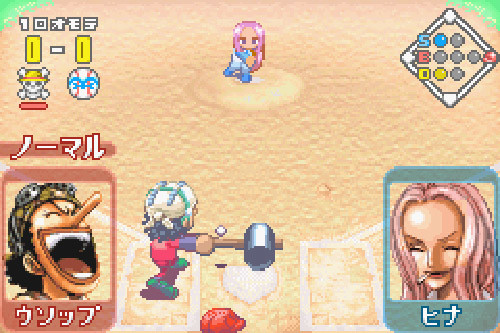
One Piece had a thing for baseball in 2004: a short entitled Take Aim! The Pirate Baseball King! accompanied the fifth One Piece theatrical movie that year, and it ties directly into One Piece: Going Baseball for the Game Boy Advance. The game lets the Strawhats and their rival pirates try traditional baseball, and with eight different clubs it had the largest roster of playable One Piece characters yet. The series isn't the only popular anime to go baseball (Doraemon built an entire spin-off into Dorabase, after all), and the playfield rarely has space to embody the bizarre powers of One Piece pirates. Still, it's a welcome break from the parade of One Piece fighters, RPGs, fighters, board games, and fighters.
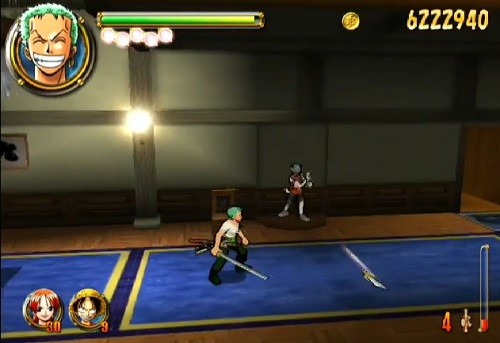
For those One Piece fans who preferred something more conventional, One Piece: Round the Land launched the series onto the PlayStation 2 in 2004. The cel-shaded 3-D graphics are sharper than previous PlayStation outings, though the game sticks to a basic side-scrolling format and opts for an original, non-canonical story about a giant named Blyue. Round the Land stood out, however, when its European release made it the second One Piece title to leave Japan, in a sign of changing fortunes for the pirate saga.
By 2004, One Piece was due for an American launch. Kids were snapping up anime and manga across the nation, and VIZ already had translated One Piece books ready for speed-reading at any local Barnes & Noble. The One Piece anime lay in the hands of 4kids, who'd previously adapted Pokemon, and such a union couldn't possibly collapse in a horrendous spectacle.
The time was right for One Piece games to assail the North American market, but just how would they do it?
That's it for Part 1 of our history of One Piece games. Come back for Part 2 and we'll see just how One Piece games came to America and how everything worked out in the end!
discuss this in the forum (4 posts) |